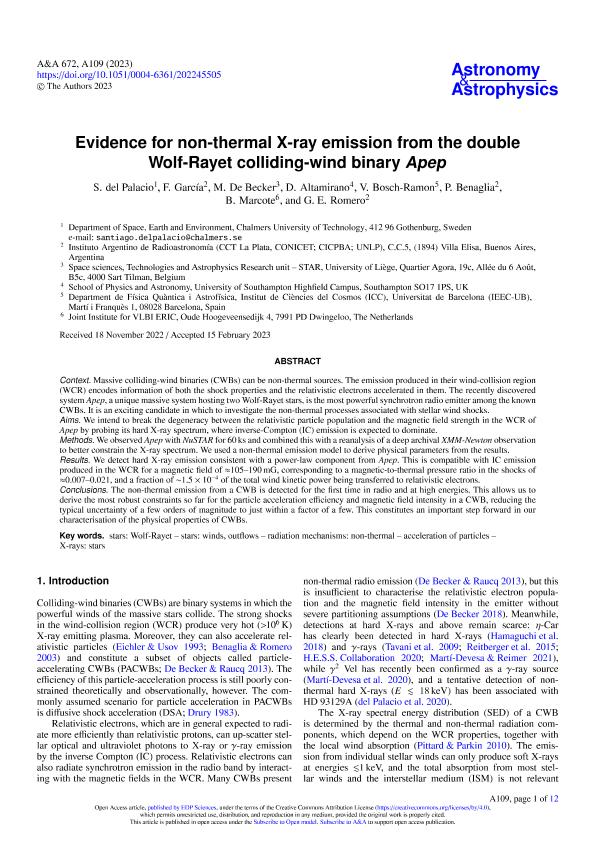Mostrar el registro sencillo del ítem
dc.contributor.author
del Palacio, Santiago

dc.contributor.author
García, Federico

dc.contributor.author
De Becker, M.
dc.contributor.author
Altamirano, D.
dc.contributor.author
Bosch Ramon, Valentí

dc.contributor.author
Benaglia, Paula

dc.contributor.author
Marcote, B.
dc.contributor.author
Romero, Gustavo Esteban

dc.date.available
2023-11-14T14:54:56Z
dc.date.issued
2023-04
dc.identifier.citation
del Palacio, Santiago; García, Federico; De Becker, M.; Altamirano, D.; Bosch Ramon, Valentí; et al.; Evidence for non-thermal X-ray emission from the double Wolf-Rayet colliding-wind binary Apep; EDP Sciences; Astronomy and Astrophysics; 672; A109; 4-2023; 1-12
dc.identifier.issn
0004-6361
dc.identifier.uri
http://hdl.handle.net/11336/218056
dc.description.abstract
Context. Massive colliding-wind binaries (CWBs) can be non-thermal sources. The emission produced in their wind-collision region (WCR) encodes information of both the shock properties and the relativistic electrons accelerated in them. The recently discovered system Apep, a unique massive system hosting two Wolf-Rayet stars, is the most powerful synchrotron radio emitter among the known CWBs. It is an exciting candidate in which to investigate the non-thermal processes associated with stellar wind shocks. Aims. We intend to break the degeneracy between the relativistic particle population and the magnetic field strength in the WCR of Apep by probing its hard X-ray spectrum, where inverse-Compton (IC) emission is expected to dominate. Methods. We observed Apep with NuSTAR for 60 ks and combined this with a reanalysis of a deep archival XMM-Newton observation to better constrain the X-ray spectrum. We used a non-thermal emission model to derive physical parameters from the results. Results. We detect hard X-ray emission consistent with a power-law component from Apep. This is compatible with IC emission produced in the WCR for a magnetic field of ≈ 105-190 mG, corresponding to a magnetic-to-thermal pressure ratio in the shocks of ≈ 0.007-0.021, and a fraction of ∼1.5 × 10-4 of the total wind kinetic power being transferred to relativistic electrons. Conclusions. The non-thermal emission from a CWB is detected for the first time in radio and at high energies. This allows us to derive the most robust constraints so far for the particle acceleration efficiency and magnetic field intensity in a CWB, reducing the typical uncertainty of a few orders of magnitude to just within a factor of a few. This constitutes an important step forward in our characterisation of the physical properties of CWBs.
dc.format
application/pdf
dc.language.iso
eng
dc.publisher
EDP Sciences

dc.rights
info:eu-repo/semantics/openAccess
dc.rights.uri
https://creativecommons.org/licenses/by-nc-sa/2.5/ar/
dc.subject
ACCELERATION OF PARTICLES
dc.subject
OUTFLOWS
dc.subject
RADIATION MECHANISMS: NON-THERMAL
dc.subject
STARS: WINDS
dc.subject
STARS: WOLF-RAYET
dc.subject
X-RAYS: STARS
dc.subject.classification
Astronomía

dc.subject.classification
Ciencias Físicas

dc.subject.classification
CIENCIAS NATURALES Y EXACTAS

dc.title
Evidence for non-thermal X-ray emission from the double Wolf-Rayet colliding-wind binary Apep
dc.type
info:eu-repo/semantics/article
dc.type
info:ar-repo/semantics/artículo
dc.type
info:eu-repo/semantics/publishedVersion
dc.date.updated
2023-11-13T15:50:48Z
dc.journal.volume
672
dc.journal.number
A109
dc.journal.pagination
1-12
dc.journal.pais
Francia

dc.description.fil
Fil: del Palacio, Santiago. Chalmers University of Technology; Suecia
dc.description.fil
Fil: García, Federico. Provincia de Buenos Aires. Gobernación. Comisión de Investigaciones Científicas. Instituto Argentino de Radioastronomía. Consejo Nacional de Investigaciones Científicas y Técnicas. Centro Científico Tecnológico Conicet - La Plata. Instituto Argentino de Radioastronomía; Argentina
dc.description.fil
Fil: De Becker, M.. Université de Liège; Bélgica
dc.description.fil
Fil: Altamirano, D.. University of Southampton; Reino Unido
dc.description.fil
Fil: Bosch Ramon, Valentí. Universidad de Barcelona; España
dc.description.fil
Fil: Benaglia, Paula. Provincia de Buenos Aires. Gobernación. Comisión de Investigaciones Científicas. Instituto Argentino de Radioastronomía. Consejo Nacional de Investigaciones Científicas y Técnicas. Centro Científico Tecnológico Conicet - La Plata. Instituto Argentino de Radioastronomía; Argentina
dc.description.fil
Fil: Marcote, B.. Joint Institute For Vlbi Eric; Países Bajos
dc.description.fil
Fil: Romero, Gustavo Esteban. Provincia de Buenos Aires. Gobernación. Comisión de Investigaciones Científicas. Instituto Argentino de Radioastronomía. Consejo Nacional de Investigaciones Científicas y Técnicas. Centro Científico Tecnológico Conicet - La Plata. Instituto Argentino de Radioastronomía; Argentina
dc.journal.title
Astronomy and Astrophysics

dc.relation.alternativeid
info:eu-repo/semantics/altIdentifier/url/https://www.aanda.org/articles/aa/full_html/2023/04/aa45505-22/aa45505-22.html
dc.relation.alternativeid
info:eu-repo/semantics/altIdentifier/doi/https://doi.org/10.1051/0004-6361/202245505
Archivos asociados
